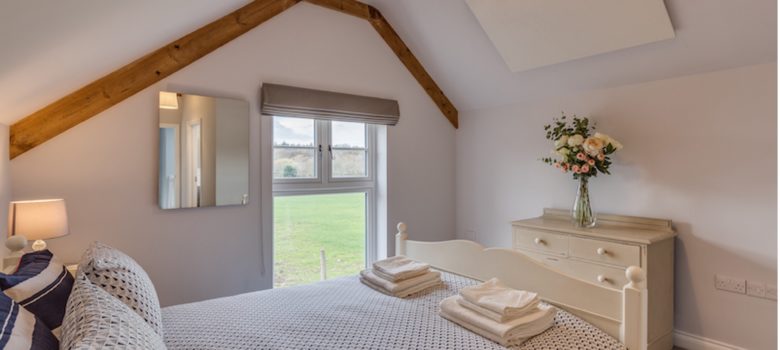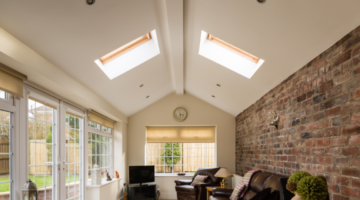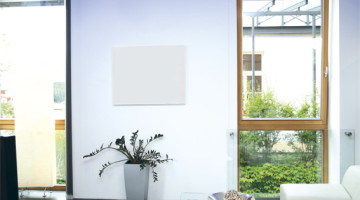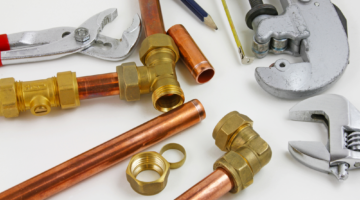
Meeting your heating requirements with infrared heating panels
On the whole, an infrared heating panel will heat one square metre of space for every 50 Watts of power supplied to the unit. Take an 800-Watt panel for example this will heat an area of approximately 12m2 in an average property.
Having said that, other variables also have a part to play in the heating ability of infrared heating panels. These include the quality of existing insulation, the temperature of the outside environment and the temperature the household tends to set its thermostat.
The Thermal envelope of the property and infrared heating panels
The level of insulation, the quality of glazing and the airtightness of a building are key factors in determining how much heat is retained. Each building fabric will offer a different thermal insulating performance, and this must be taken into consideration when you are sizing panels.
If you have good quality insulation, for example, then the heating panels will be at their most effective – warming the room quickly, then modulating on and off to top up the heat as required. The better insulated the walls and the roof space, the more heat will be retained and the less the panels will need to work.
If, on the other hand, you live in a period property and you have solid walls; or if you live in house with unfilled cavities, then installing insulation prior to putting up the heating panels may be a sensible idea. Loft insulation, for example, is cheap and easy to install. Ideally this should be be done prior to installing the panels, since once in place, the insulation would help limit the heat loss from the home when the panels were switched on.
How infrared heaters work
Infrared heating panels work by emitting infrared radiation; this is then absorbed by an object, which in turn will then warm up. The residents should be able to feel a comfortable level of warmth, even though the air temperature may be lower than you would normally experience with a traditional radiator heating system (which relies on convection heating).
If the heating panel is positioned on the wall, a certain amount of infrared radiation will be aimed at the ceiling and will get absorbed. As a result, this energy will not be felt directly by any people in the room. Therefore, positioning heating panels on the walls may limit the heating area by as much as 20%.
In an ideal world, the panels would be positioned on the ceiling; however, this is slightly dependent on whether the plasterboard is able to support that weight from the panels. If in doubt, seek advice from a construction expert or an electrician before installation.
It is important to touch on shading when talking about infrared heating; if the radiation is absorbed by something before it reaches the intended target, then the target won’t get warm. This is very similar to the effect of moving from direct sunlight into the shade – you will suddenly feel colder. This is because the sun does the bulk of its heating via infrared radiation (this is 100% safe and different from UV rays). The same thing happens in the home; if a table absorbs the infrared, the floor underneath it will not warm up.
To achieve a more all-around warm feeling, similar to what you would experience with a traditional central heating system, the heating panel needs time to warm the walls and furniture. These then give off warmth and effectively act as secondary heaters. Solid stone or brick walls take time to heat up, but then give off warmth nicely.
According to a study made by Wolverhampton University using Jigsaw infrared heating panels Gas central heating can often take around 30 minutes before occupants can start to feel the warmth as it heats the air within the space. Infrared heating heats objects, not the air, meaning that the warmth can be felt much quicker, normally less than 10 minutes. The Infrared system is so quick at heating that they can be controlled by motion sensors. The panels only come on when there is a person in the room.
Infrared heaters reduce condensation
Cold walls tend to cool the warm air created by conventional central heating and can cause condensation, whereas infrared heating is designed to heat the walls and the contents of the room. The fact the walls are heated means they will stay dry, reducing condensation and helping prevent the build-up of mould. Installing infrared heating means the objects are heated in addition to the air around them. Because of this, the panels can be directed towards damp walls to dry the wet areas and reduce the formation of mould.
How much heating output does my home require?
The sizing information we give is based upon a fairly well-constructed and relatively well-insulated home. As a result, we assume your home requires 50 watts per m2; however, this can be more like 100 or even 150 watts per m2 for an uninsulated house or commercial premises. The customer should always do some background research and assess how well insulated and thermally efficient their property is.
The other element to factor in is the temperature the homeowner would like to heat their property to. A recommended ambient temperature is normally between 18 and 22 degrees C; however, if you like to heat your home at 30 degrees then you will require more watts per m2 – and this will obviously cost you more to do.
A room thermostat and programmer may also help you take control of the heating. By fitting a room programmer, you can judge the warm-up period and cool-down time needed, and also set a lower daytime temperature just to prevent the room from becoming too cold. A thermostat will help prevent electricity from being wasted, by turning the heater on and off to maintain a set temperature. This is especially useful in spring and autumn when the weather is changeable and also in winter to keep a general warmth to the room rather than letting it get very cold and then having to use lots of power to boost the warmth up.
When installing Jigsaw control systems for the infrared heating panels you will need one Hub at £129 and a room thermostat for each room at £89 and any added extras to make the most of your efficiency. This can be set at several different times and temperatures throughout the day while only directing the heaters to heat a room in use via an app.
When using the Jigsaw control system IR heating system, it is recommended to heat the room temperature to 22-23 degrees compared to up to 18.5 with gas central heating.
If you do decide to hang the infrared panels on the wall, you also need to consider where on the wall you are going to hang them. Infrared rays travel about 3 metres out of the panel, so a central position on the longest wall is preferable. Positioning at one end of the room and leaving areas unreachable will, unfortunately, produce cold spots, so you may wish to consider two panels if this is the case.
For the best results contact your supplier for a quote on where the most efficient place is to install your infrared heating system. Click here to get direct access to book a free quote from Jigsaw infrared.
Questions to ask yourself before installing an infrared heating panel
Q: What is the area/room size you are trying to heat?
A: The bigger the room, the more heating output you will require to get it up to comfortable temperature.
Q: What is the construction of the room/house – is it an old stone building, a modern building? Assess the level of existing insulation.
A: Older, solid wall properties will be less insulated, which means the rays are absorbed more by the fabric of the building; which in turn means less useful heat will radiate back into the room. So you may require more watts per m2.
Q: How many walls are external?
A: The more external walls that the heated area is exposed to, the more likely that heat will escape and radiate outside the building. Again this is where insulation is important, so determining how well the walls are insulated will have an impact on the heating requirement per m2. The better the insulation (filled cavity or solid wall insulation), the more likely the heat will remain in the room/s and keep that useful warmth, so the panels need to work less hard.
Q: What type of glazing do you have? Is it single or double and what is the size that occupies the walls?
A: If the answer is single glazing and the amount of area is large, then you will require higher output wattage than the 50 watts per m2 that we recommend.
Q: What height is the ceiling?
A: Domestic panels work optimally up to 3m in room height. If you have higher ceilings you can contact us and we will give you further guidance.
Q: Where do you think you will be placing the panels – ceiling or walls?
A: If you place the panels on the walls, ensure they are at least 1 metre from the ground. Some of the bigger panels will require a bigger gap of at least 2metres. On the other hand, if the panels are installed on the ceiling, make sure the plasterboard can support the weight.
Q: Will you be installing infrared heaters with thermostat and/or programmer?
A: When you have control over the temperature and running times of your panels you can ensure that energy coming in is optimised to the energy being released. The more sophisticated the setup, the more it will work around your lifestyle and operate efficiently to minimise wastage.
Benefits
- Infrared panels heat objects, not the air, so cold draughts have less of an impact.
- Infrared panels are incredibly easy to install, requiring no pipework. They are just plug-in and go.
Limitations
- Shading will impact the infrared heating, if an object impedes the infrared radiation, the intended target will not get warm.
Cost
- Infrared panels vary in price depending on the size of the panel, but prices start at around £150.
Installing infrared heating
Are you thinking about installing infrared heating in your home? We have scoured the country for the best tradespeople, so that we can make sure we only recommend those we really trust.
If you would like us to find you a local installer to help install infrared heating in your home, just fill in the form below and we will be in touch shortly!












One thing I am finding hard to discover – what is the energy input for say a 500 watt output panel?
input equals output when it comes to electrical resistance
Hi Richard.
It would be 500 watts! A 500w panel (plus or minus 5%) will have the same input as output. It’s one unit in, one out because infrared is an 100% efficient form of electric heating.
The 100% efficient description appears on a lot of websites and it is true that 100% of the electricity going into the panel is converted into heat. What it misses though is what percentage is converted to infrared radiation and what percentage is converted to “normal” heat and given off via convection.
One of the top Austrian infrared panel manufaturers states that their panels have been independently verified to have a radiation rate of 72% and that this is higher than most other panels. This is the measurement that’s missing for most panels on the market (along with an analysis of the emitted spectrum).
Hello. If someone 1.9 metres tall stands directly under a 1000W infrared panel fitted to a ceiling 2.5 metres high, what temperature will the infrared rays induce in the person’s head, and in their feet? With thanks.
Hot and not so hot
Hi I have 3m ceiling height in my living room, there are 2 economy 7 storage heaters in that room of about 23sqm. I would like to put one infrared heater on the ceiling to complement when the economy 7 looses heat at the end of the day. Can you recommend?